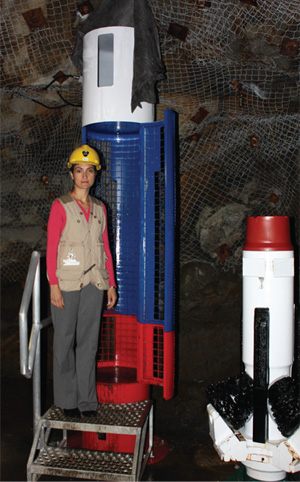 The rescue of 33 Chilean miners after more than two months underground this past fall had the rapt attention of billions around the world. Two Northern Ontario companies, Cementation Canada and Mining Technologies International (MTI), were called upon to assist.
The rescue of 33 Chilean miners after more than two months underground this past fall had the rapt attention of billions around the world. Two Northern Ontario companies, Cementation Canada and Mining Technologies International (MTI), were called upon to assist.
Mia Boiridy, director of Dynamic Earth, Sudbury’s geoscience centre, thought that highlighting the rescue effort at the popular tourist attraction would be a great way to educate the public about the mining industry and the technology used to bring the miners to surface
“It is important for visitors to understand, first of all, that the exhibit is not just about the rescue, but the technology that went into it … for a successful rescue mission,” said Boiridy. “I also wanted to give Northern Ontario companies an opportunity to talk about their capacity to build the upreamer for the rescue in such a short time.”
The exhibit, which opened in March, is located in the underground tunnel at Dynamic Earth. It consists of a replica of the Fenix, the 54-centimetre capsule used to hoist the miners to surface, and the upreamer built by MTI to ream out a hole bored for the so-called Plan A rescue effort. This effort was led by Teracem, a Chilean company jointly owned by Cementation Canada of North Bay and Teraservice SA, a Chilean drilling services company.
“The actual Fenix is in Chile, but there are three prototypes, one of which will be on exhibit at the Smithsonian (Museum in Washington, D.C.),” said Boiridy.
The Chilean Navy and NASA designed the stainless steel capsule. It was designed with wheels to smooth the ride up the drilled hole. It also had an oxygen supply, communications equipment, lighting, and an escape hatch and lowering mechanism if the capsule got stuck.
Boiridy heard Roy Slack, president of Cementation Canada, make a presentation about his company’s role in the rescue mission and asked him to help develop the exhibit.
The reamer head was designed to be sent down the drilled hole and assembled by the miners underground. Once assembled, it was to be joined to the drill string and drilled up towards the surface to a diameter of 28 inches.
The reamer was designed by Atlas Copco in Texas and built in Sudbury at MTI.
“It took 10 days to build with 24/7 attention,” said MTI general manager Mick Hardwick. “It was the first time making this upreamer and it was specific for the rescue.”
The reamer never left Sudbury because the Plan B rescue effort, relying on a Schramm T130XD well drilling rig and drilling hammers from Center Rock Inc. of Berlin, Pennsylvania, succeeded first in drilling a hole wide enough to bring the miners back to surface.
Specialty Alloys and Stainless Ltd. of Sudbury fabricated the replica of the capsule based on drawings created through reverse engineering.
“Visitors love it,” says Boiridy. “What they really appreciate is the fact that they can go inside the capsule. They can get in the shoes of a miner and see what it would have been like to ride in this capsule for the 20 minutes it took to reach the surface.”
Boiridy sees value in adding more displays to educate visitors about safety and rescue operations in mining. “I would like to profile all three plans - not just the capsule. There were three very different technologies.”
The capsule and reamer will remain as part of the underground exhibit at Dynamic Earth.
www.sciencenorth.ca/dynamic-earth

